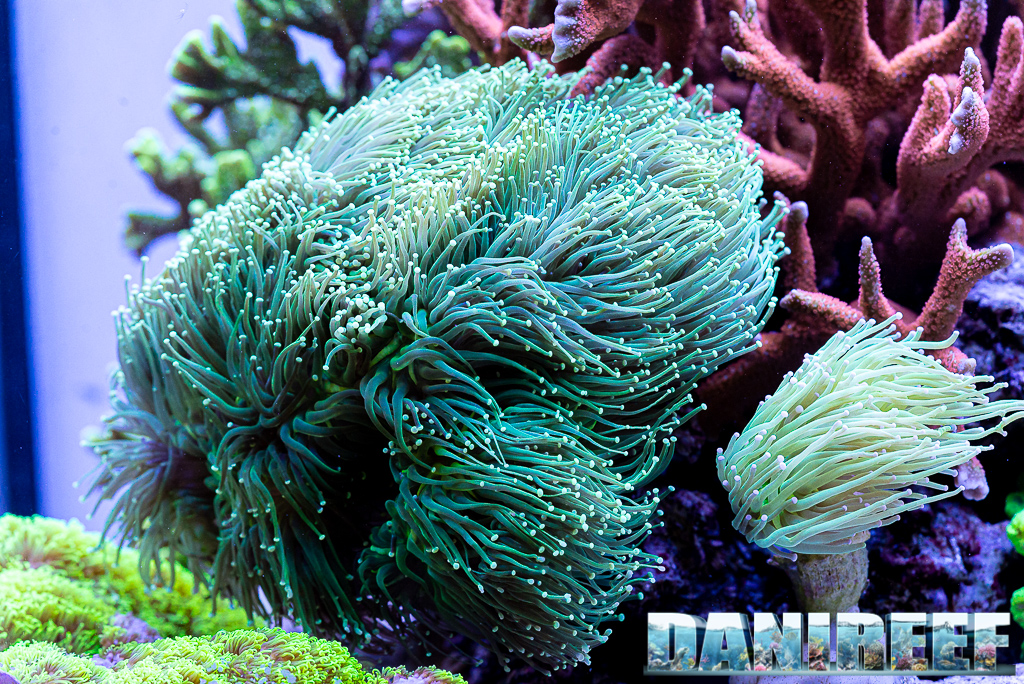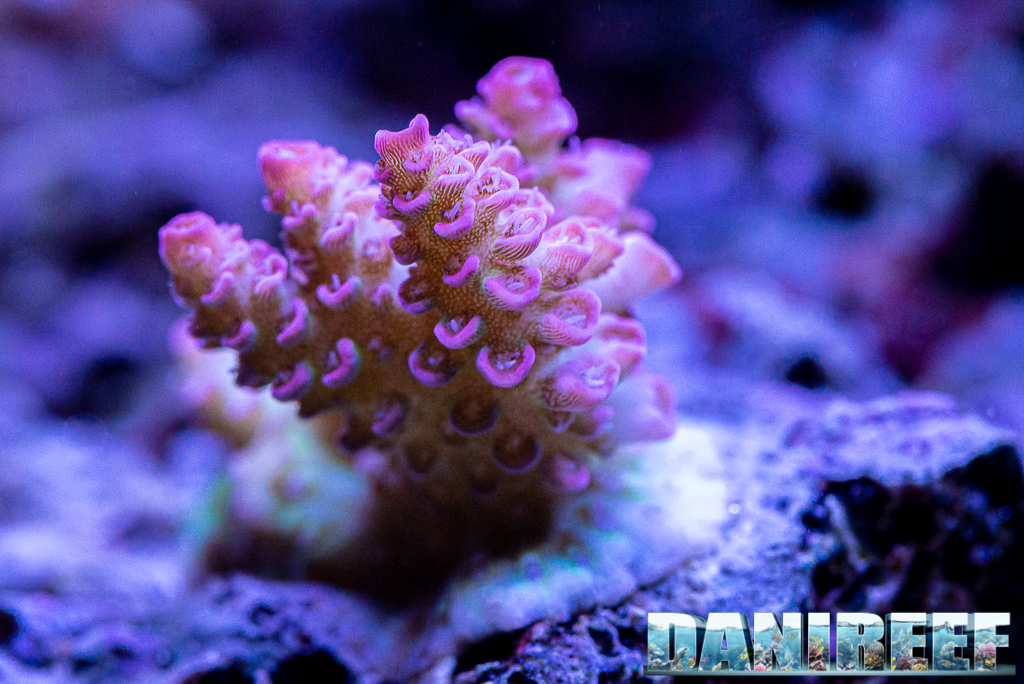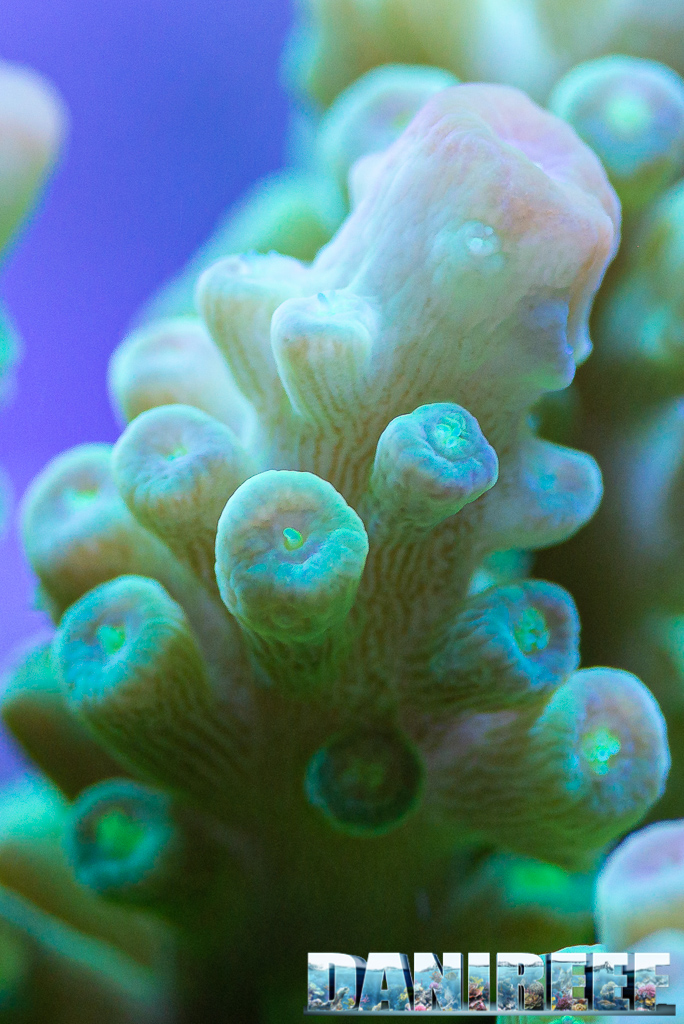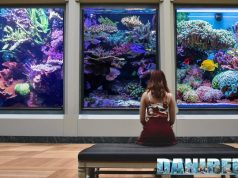
Some days ago we had the great honor to take pictures of the beautiful Luca Perini‘s reef aquarium with SPS, Acropora, Montipora and Stylophora corals.
This article is also available in: italiano
It’s a 300 liters aquarium that impresses with the size and the color of the animals contained. All in good health and harmony!
I met Luca in our aquarium dedicated forum where he writes with the nickname of Luper. Since the beginning, after seeing pictures of his aquarium, I asked him to let me see that beauty in person. In truth, from the idea to the realization, years have passed (also due to the problems caused by Coronavirus). But, in the end, after such a long time of waiting, we were able to see this beautiful aquarium, and we surely weren’t disappointed. The tank is amazing, and what stands out is Luca’s thoroughness and his great accuracy. The animals are beautiful and in full health, but some LPS, but when you’ll see the fish he breeds everything will come clear.
Seen live the aquarium is even more beautiful than the photos we took, as it always happens with any aquarium, but I have to say that the media contributions give the idea.
But now let’s talk about the aquarium! The tank has 300 liters of capacity, and its size is 110x50x55(h) with glasses of 12 mm. The light comes from a couple of GNC BluRay PRO. And given the occasion we took the opportunity to test the ceiling lights and do an episode of DaniReef LAB on the road, so stay tuned because soon we’re going to release the dedicated article. But in our video you’ll already see the measurement of the PAR in aquarium.
The remaining of the technique has been updated thinking about the possibility that Luca will change for a bigger aquarium, but all the accessories are of great quality. But let Luca tell the story!
He started his first aquarium at 14 years old, and he had marine aquariums at 17. He’s actually waiting to get merried with Letizia, and they have two beautiful children in Reggiolo and he works in a car service.

Our video of Luca Perini’s (Luper) aquarium
As usual we shoot a beautiful video of Luca‘s aquarium, where we played with Orphek lenses (that we will explore in a dedicated article soon) in order to show the colors as real as possible. The video has been shoot in 4k so I suggest to set it full screen to enjoy it better. Then you can come back to the article, to read everything about the system of the tank and to watch the photographs of the corals and their zooxhantellae and the fish! As always, the video is in italian language, but you can turn the English subs on!
The history of the aquarium
Hi Luca, thank you for having us. Do you like to tell us the history of your passion? How did you grow and the choices that you made?
“As you have correctly said I began my relationship with aquariums at 14, and the addiction continues if you consider that now I’m forty and I still have aquariums in my home. I currently have two, both in my living room. The first marine aquarium, anyway, arrived three years after my first fresh water. But first I had to understand its peculiarity“.

Do you have any funny story to tell us?
“Well, I do have a story, but it’s more tragic than funny. As you can see I have a freshwater aquarium at 60 cm from the marine one. One evening, I had just come back home, and I saw a Valenciennea that had jumped in the freshwater aquarium. Unluckily, when I noticed, it was already dead, at the bottom of the aquarium“.

“I upgraded the technical equipment in the last months because lately I have this project to enlarge… Especially to regain the depth I miss so much now that I only have 50 cm. So, the idea is to have 120x66x55h (about 435 liters)“.

The partial changes
Luca, now let’s talk about your technique and the specific managing of your aquarium. Let’s begin with the partial changes, a topic that we discussed a lot in the past, even with interventions of international guest (here in italian).
“At first I admit I was skeptical about water changes. As time passed, and the water matured, I dilated the procedure. I usually watch the redox value, managed by Aquatronica, and when it’s too high I do the change. Approximately I do it once a month and a half. I change 25 liters, that’s about the 10% of the volume of the aquarium.
The tank as you can see it now celebrates two years in May. But this because we moved in this new house (very beautiful ndr). The tank was born in 2012 and the aquarium is by Vitrea“.
I take the word to remind that Vitrea, an italian company that went very well with great products, and that we visited at the Interzoo in 2008 and at the Zoomark in 2009, it completely disappeared after the big eartquake that hit the central Italy in 2009. It’s a real pity… It has been a great company.
“For once the aquarium was very well build. The only wrong note was the bottom drain that I removed siliconing another sheet of glass, then I added an external load and drain UltraReef of 40. Since then I reset the aquarium many times. The last one has been after the move. Obviously, I keep the animals and the living rocks“.

“I also tried different salts, but lately I’ve been using Xaqua DNA Salt + minerals and I’m very happy with it“.

Filtering system and sump
What’s the most impressive thing is the order that reigns in the sump. All seems perfectly in its place. Do you want to tell us about the organisation of the sump and the system that you use to manage your reef aquarium?
“Well, let’s say that I like to keep things in order. The sump was born divided, with a lateral refill tank. It has a compartment between the skimmer and the return pump and all the system is based on the calcium reactor. As you can see from the pictures the drain pipe is on the right, behind the calcium reactor.”

“On the left there’s the Aquatronica unit, a couple of electrical panels and the power supplies. Between the refill and the electric part I usually keep the products to adiminster and the CO2 cylinder”.


“Load and drain are UltraReef of 40 mm and the return pump is a Sicce 2.5. Actually the return pipe is a bit dirty and I think that the pump too has to be cleaned, at least after the head values you measured, of only 324 l/h. The skimmer is a wonderful UltraReef UKS 180 (here our review), the partition between the foaming chamber and the return pump is 22 cm of height. The calcium reactor is a rc120 by Xaqua loaded with jumbo coraline, followed by a 250ml post reactor loaded with aluminic resins always by Xaqua“.

“The technical part is completed by a heater Schego da 300 watt. The heater is managed by Aquatronica and I set it in order to keep the temperature in aquarium of 24,5 in winter and 25,5 – 26° in summer. Then in summer I also set the chiller Teco TK500 next to the aquarium“.

The lighting based on 2 ceiling lights GNC BluRay PRO
Luca, tell us about the lighting, now that we can see a couple of GNC BluRay PRO in an aquarium. We are so enthusiast that we measured the PAR making an episode of DaniReef LAB away. But for this data you’ll need to wait some days more.


“I think that lighting is the crucial point for a crucial aquarium. I decided to opt for a couple of GNC BluRay PRO (review soon! ndr.), which are beautiful to see and they’ve a fantastic coverage. The PAR measured in aquarium are on an average of 600 PAR on the corals, decreasing a bit on the bottom. Sure these values are enforced by the reflection of the glass, and mine is particularly tight. In addiction these ceiling lights don’t consume so much, so with a relative low consumption I think I have a great result.“.

How are set the ceiling lights so that you obtain these wonderful and bright colors?
“The GNC BluRay PRO are set on a daily cicle of 12 hours. In these 12 hours there are 1 hour of sunrise and 1 of sunset. The channels aren’t set on their maximum, even if we measured the PAR with the channels at maximum. I set them this way:
- Blues: 90%
- Whites: 65%
- Reds/UV: 80%

The movement
Luca right now we’re talkikng about the technique behind your aquarium, but we left aside a fundamental aspect: the movement.
“Yes, I also believe that in a reef aquarium the movement is a crucial aspect. I think I didn’t skimp, since I have a couple of Ecotech Marine Vortech MP40QD“.

How did you set the Vortech to obtain the maximum for your aquarium?
“The two Vortech work asynchronously, when one pushes the other go slower and vice versa. The modalities of functioning are Gyre or Reef Crest that alternate every 4 hours. The maximum power is set between 60 at 65% depending on the hour of the day and the modality“.

The technological management
Luca, we noticed that your aquarium is managed by Aquatronica, our first love in aquarium controllers!
“Yes! I use Aquatronica with a pH probe for the control of the calcium reactor, redox probe and obviously a temperature probe. In addiction, Aquatronica manages the sump when the level is too low or too high. Finally, I have the SMS module to be alerted in case the power goes down. I also use it to control the values of the probes remotely“.

“For the refill I use the Hydor Smart Level Control instead. But I disabilited the buzzer which was very annoying“.
The values of the water and Luper’s set
Tell us about the values you keep in aquarium, that we know being a little different from the usual, and explain us why.
“You’re right, the values are pretty high. Starting with the salinity: 36 per one thousand. But this helps me to have a solution with higher values, in fact I usually keep the calcium between 450 and 500, the magnesium between1450 and1500 and the KH between 9 and10“.

Well, Luca, these are really high values, that we tend not to recommend. So we’re curious to know the reasons behind your choice.
“Well, I started to keep higher values one year ago. Since then I never had a problem and the animals were in great shape. And if you consider that my aquarium consumes a considerable quantity of calcium you understand why I rather keep high values than the opposite. I measure calcium and magnesium once a week and the KH 2 times a week. Consider that the reactor has 2,5 liters of coral and I use half of it every month and a half. For all these reasons these high values helps me not to suffer when they decrease“.

And for what regards the organics? Seen the aquarium we think they’re too low, but we want to hear what you think about.
“I don’t measure the organics too much, last time I measure nitrates they were 0,2 and the phosphates and the ICP were very low. The phosphorus was 0,003 ppm. So, from this point of view, is a very lean tank“.
| The values in Luca Perini’s (Luper) aquarium | Header lable |
|---|---|
| Salinity | 36 per thousand |
| Calcium | 450-500 ppm |
| Magnesium | 145-1500 ppm |
| KH | 9-10 dKH |
| Nitrates | 0,2 ppm |
| Phosphorus | 0,003 ppm |

Trace elements and feed of the organisms
The corals, as we can see them, are rich of colors, and the typical pastel colors of the bacterial reproductions. What can you share with us?
“The aquarium is treated with the bacterial reproduction helped by Xaqua Bio One, even if lately I’m also dosing Vodka too“.

“As feed for corals I use Xaqua, with Koral Bull and Koral GF and aminoacids once a week. While for the fish I use both dried and frozen feed, starting with Xaqua Marine, the granular SHG and Aquaforest“.

“As trace elements I use the Xaqua Kroma RGB protocol, iodium and iron“.
Special thanks
Now that we’re at the end of the interview, and before the due compliments, do you want to add something?
“Yes. First of all, I want to thank my partner Letizia, that soon will be my wife (ndr: Congrats!!!), which has the patience of a saint, otherwise it would have been impossible to reach these results“.

“Then I would like to thank all the forum of DaniReef, and you Danilo in particular, for this opportunity to have a place in which we can daily confront and where I always find the inspiration to grow“.
“My last thought goes to Marco Gherardi, Xaqua responsible, a friend with whom I often discuss about the managing of the aquarium and to Gabriele of AquariumLab, my reference store for over 20 years“.
DaniReef’s comment
As we said in the opening we strongly wanted to take pictures of this aquarium after seeing the first picture on our forum. We were so happy for the opportunity.
The aquarium is amazing, harmonious, with well grown corals and an high number of fish, even if they often hide. We were also curious to see the GNC BluRay PRO in action. Then we can only congratulate with Luca for his aquarium and how he manages it, for the hospitality that he and his bride to be reserved for us besides the short notice.

Technically speaking we know that we’re referring to a system that Luca is going to change soon, but we wanted to share our thoughts anyway.
Right now the skimmer is oversized for an aquarium of 300 liters. Luca‘s luck, we think, is to have an underpowered return pump (it has a rate of only 324 liters per hour) that, practically, doesn’t make the skimmer work as it should. We know the Akula 180 very well, for having reviewed it here: UltraReef Akula uks-180 – in depth review. UltraReef speaks of a rate of 1.400 l/h. It’s clear that having only 324, the efficiency of the skimmer is compromised. Obviously with a less powerful skimmer you would have obtained the same result. For this kind of skimmer you should have a return pump of at least 1.400 l/h.

If you want to deepen the topic of the dinamics between return pump and skimmer we send you back to our dedicated article How to choose the right return pump in marine aquarium.
Probably this choice, in this specific case, which is a temporary solution, makes sure that you don’t have to clean excessively the aquarium and have problems of oligotrophy in tank.

The rest is high level equipment, from the pumps to the lights, everything well thought in the system of the aquarium. The SMS module of Aquatronica is very useful, as well as the chiller for the summer time.
Just to make another point, the two Vortech move 19.000 l/h each, and being them at 65% of the power they should move about 12.350 l/h each, that equals to 41 times the volume of the tank! A number even over the minimum specs of 20 times the volume. Incredible.
Speaking of the lighting we measured (you can see it in the video) about 600 PAR, good enough to breed practically everything. We have to specify we did the test with the lamps at their maximum, and not as Luca set them. But we shouldn’t find many differences.

One thing that sounded weird are the high values Luca keeps in the tank. We think that 35 per thousand should be sufficiently high to manage even eventual problems to the calcium reactor. We also don’t see the benefits to have calcium and magnesium so high, even higher than in nature. But the beautiful thing of this hobby is that you can discuss of anything and make the tanks grow with different ideas. At the end, these are litte things. The Red Sea has 38 per thousand of salinity and there the corals live very well.


The Pomacanthus imperator, however young, and the Paracanthurus hepatus, seem to be a little tight in this tank, we hope that soon will come the new aquarium. Moreover, the presence of these angelfish, Pomacanthus imperator, Centropyge bicolor and Centropyge bispinosus doesn’t leave much space to LPS.

So, we wanto to congratulate again with Luca and his beautiful aquarium, very colorful and rich of animals. The colors and the harmony are a real show. It’s obvious that behind the aquarium thare’s a passionate and meticulous aquarist. Very well done Luca!

You only have to scroll down the rest of the article to see the pictures of the corals on page two and the fish on page three. They sure are beatiful!














